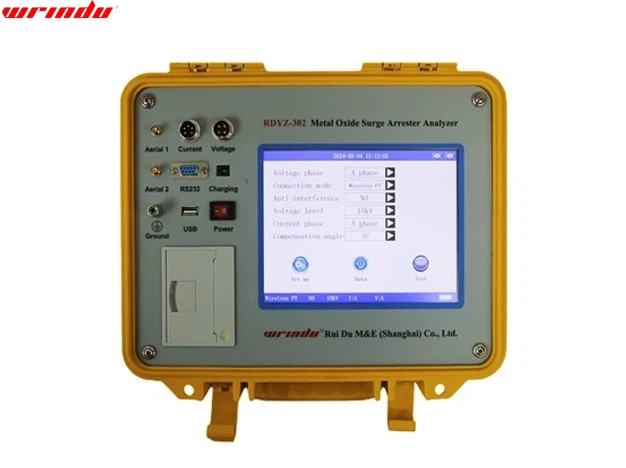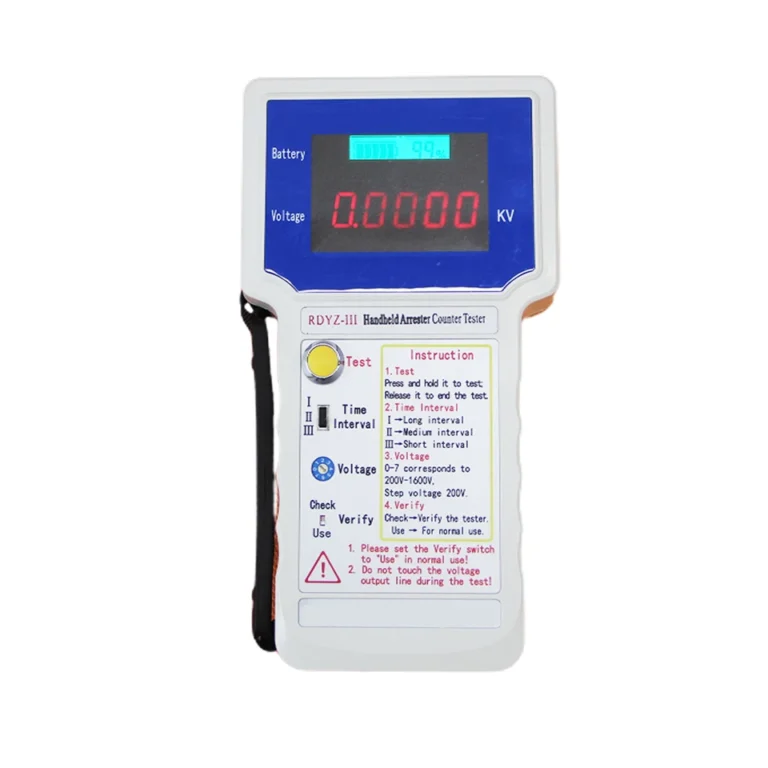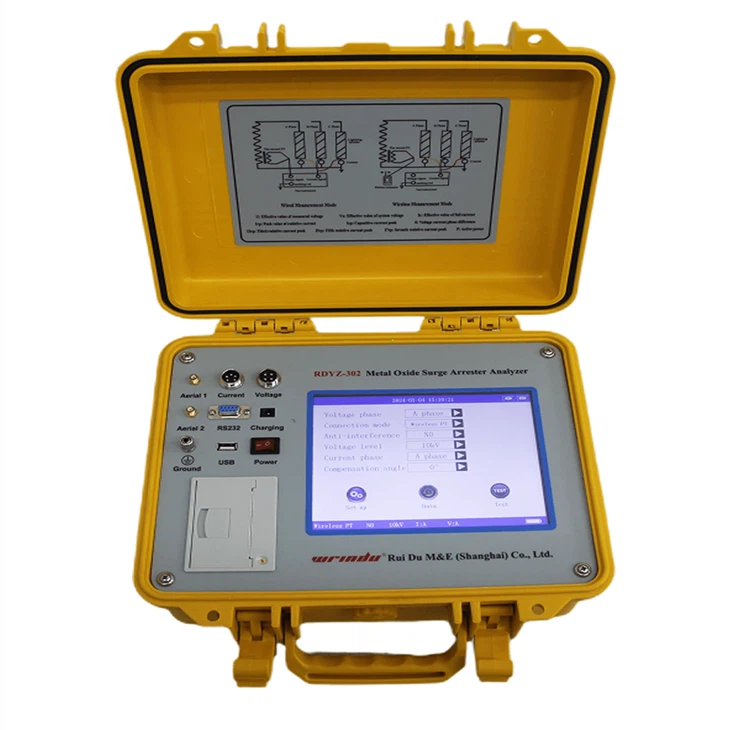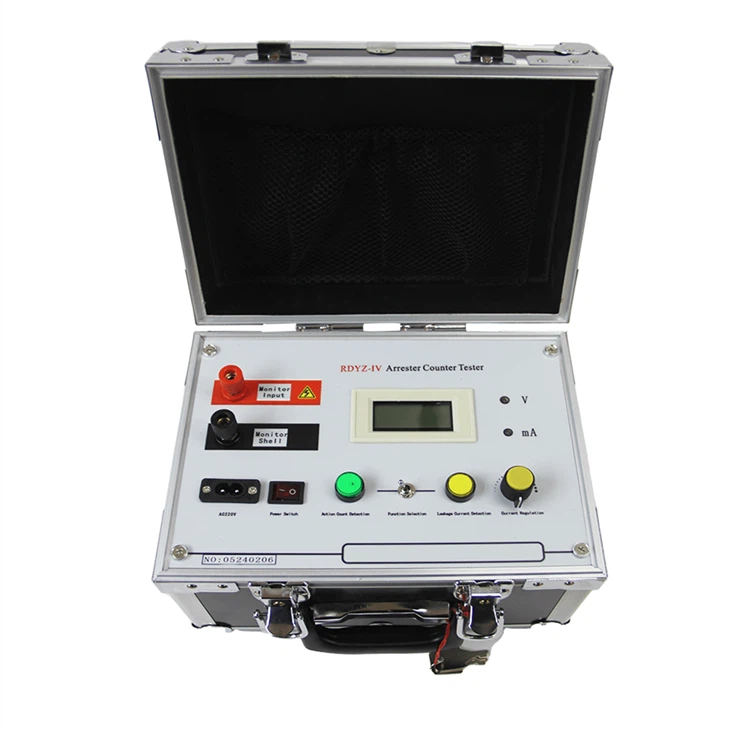Lightning arrester testing
As a manufacturer of Lightning Arrester and Insulator tester, Rui Du specializes in the design and manufacturing of high-precision electrical equipment. With over 10 years of export experience, we have established a comprehensive service system that includes design, production, inspection, and after-sales support. We can customize various testing instruments according to our customers’ requirements to meet their diverse needs. You can learn more about us through the following product introductions or by contacting our professional service team directly.

What is Lightning Arrester And Insulator Tester?
Lightning arresters are essential for protecting electrical systems from damage caused by lightning strikes. Environmental factors can degrade the performance of these devices over time, so regular testing is essential for their efficiency. The Metal Oxide Surge Arrester Analyzer is a real-time monitoring tool that can detect problems such as moisture in the insulation or aging of the valve plate. In addition, the Lightning Arrester In-Line Detector Calibrator can also test the number of lightning strikes and leakage current peaks in major power facilities to ensure the reliability of the lightning arrester.
Application of Relay Protection Tester
Safe and Reliable
The instrument adopts ABS plastic shell to ensure that there is no exposed metal in the high voltage output part, thus providing safety protection for the operator and avoiding the risk of electric shock.
Large capacity lithium battery
Built-in high-capacity lithium-ion battery, a single charge can support the device to run continuously for about 6 hours.
Wireless data transmission
The use of wireless data transmission technology eliminates the wiring work of long-distance voltage measurement and greatly reduces labor intensity.
Humanized design
User-friendly menu design, with an intuitive and easy-to-operate interface. Its compact and lightweight construction makes it highly portable and ideal for field work.
How many types Lightning Arrester And Insulator Tester are there ?
Arrester Counter Tester
The lightning arrester counter tester is designed to produce the specific voltage and current needed to activate the counter, replicating the real-world conditions in which the counter operates. This enables us to assess whether the counter is functioning properly. Additionally, the arrester online detector calibrator is an instrument specifically crafted for evaluating the discharge counter at the lower end of the arrester in various facilities, including substations, hydro-thermal power plants, and the power systems of large industrial complexes and mines. It’s capable of counting the number of lightning strikes and measuring the maximum leakage current.
Metal Oxide Surge Arrester Analyzer
The Zinc Oxide Arrester Characteristic Tester is a specialized instrument designed for the live detection of zinc oxide surge arresters within power systems. It is used to monitor electrical equipment during operation, measuring AC leakage parameters to timely identify potential hazards within the equipment’s insulation, such as moisture or aging of the valve plates. The significance of this tester lies in the fact that electrical equipment, during operation, is subjected not only to normal working voltages but also to temporary overvoltages, switching voltages, and lightning overvoltages. These overvoltages can sometimes exceed the insulation tolerance levels of the equipment, potentially leading to equipment failures. Therefore, using this tester is a key method to ensure the effectiveness of overvoltage protection measures in power systems.
What is Lightning Arrester And Insulator Tester used for ?
01/ Identify potential hazards
Whether energized or de-energized, lightning arrester testing is a key means of detecting potentially dangerous defects such as moisture in the equipment’s internal insulation or deterioration of the valves.
02/ Monitoring Thermal Breakdown
Data monitoring using zinc oxide surge arrester testers is especially important when thermal breakdown occurs in the arrester, causing its heating power to exceed the heat dissipation power.
03/ Detection of moisture
If the arrester is not sealed tightly, the internal moisture invasion, often manifested as an abnormal increase in the total current, which may lead to the explosion of the arrester in serious cases. This moisture situation can be accurately detected by zinc oxide surge arrester tester.
04/ Ensuring power stability
The application of on-line zinc oxide surge arrester tester provides an efficient and reliable means to assess the health of surge arrester and ensure the stable operation of power system.
Application of Grounding And Insulation Resistance Tester
Environmental conditions
Do not work alone or in explosive gas, steam or high dust environment.
Voltage check
Before testing, make sure that the tester voltage display is not higher than 36V.
Power off of the product under test
Confirm that the tested device is in a power-off state. This instrument is not allowed to be used to test live device.
Voltage range determination
Confirm that the withstand voltage of the tested device is within the output voltage range of theselected test gear.
Electric charge release
After the test, do not take away the test line when the voltage is higher than 36V to ensure that the distributed capacitor electric charge is completely discharged.
Components of Lightning Arrester And Insulator Tester
Outside case
Charge interface
USB interface
Touch colorful screen
Function selection button
Power socket and Power switch
The difference from traditional Lightning Arrester And Insulator Tester is ?
Leveraging wireless data transmission: Our device eliminates the need for complex long-distance wiring during voltage measurements, significantly reducing the physical effort required for setup.
User-friendly menu design: The user-friendly menu design and intuitive interface make operation a breeze, with the added convenience of switching between Chinese and English interfaces.
Large storage capacity:The instrument boasts a storage capacity for up to 200 sets of test data, which can be easily exported to a USB flash drive for further analysis.
Compact and lightweight: Our device is designed for portability, making it an ideal choice for fieldwork and remote operations.
Safety first: Features an ABS plastic casing, ensuring that no metal is exposed at the high-voltage output, providing a safe operation environment that protects the user from electrical shocks.charge is completely discharged.
FAQ
Q: How do you check the health of a surge arrester?
A: A standard approach is recommended to evaluate the condition of a surge arrester. According to IEC 60099-5 standards, the most dependable method for assessing the state of a gapless surge arrester in regular operation is to monitor the resistive part of the leakage current. Alternatively, you can approximate this value by analyzing the third harmonic of the leakage current.
Q: Which test is used to evaluate the effectiveness of surge arresters?
A: To determine the effectiveness of surge arresters, a specific test is employed. You should conduct an Insulation Resistance test on each surge arrester unit. This involves applying a voltage source that exceeds 5kV and ensuring that the megger reading is higher than 10kΩ per kilovolt.
Q: What is the working principle of lightning arrestor counter?
A: The principle behind a lightning arrestor’s operation is that when a voltage surge travels along a conductor and reaches the point where the arrestor is situated, it causes a temporary breakdown of the arrestor’s insulation. This allows the surge to be safely directed towards the earth, thus dissipating the excess voltage.
Q: What is leakage current analyzer for surge arrester?
A: A Leakage Current Analyzer assesses the resistive part of continuous leakage current in gapless MOVs of surge arresters, including those in GIS. It uses a capacitive GIS coupler connected to a field probe for measurement.
Q: What is the test of surge arrestor?
A: The surge arrester undergoes a Voltage-Withstand Test, which is designed to evaluate its capacity to endure elevated voltages. The device is exposed to a voltage exceeding its normal rating for a set period to confirm its capability to withstand sudden overvoltages without breaking down.
Q: What happens if a surge arrester fails?
A: When a surge arrester malfunctions, a few key issues can arise. For one, it may cause power outages due to lightning strikes and equipment damage, which translates to lost power supply and additional expenses for the utility company. Additionally, if surge arresters fail during an overvoltage event, it can jeopardize the safety of substations and compromise their operational dependability.
Q: How do you test a surge arrester?
A: To evaluate the condition of a surge arrester, a common approach is to monitor its surface temperature. This is typically done using an AC or DC Hipot tester, also referred to as a Dielectric Test instrument, to check the arrester’s integrity in the field.
Q: When should I replace my surge arrester?
A: It’s advisable to swap out your surge arrester every 3 to 5 years, or immediately if you detect any visible damage or operational issues. Additionally, you should refer to the manufacturer’s warranty or specifications to determine the surge protector’s capacity for handling energy before replacement is necessary.
Q: What is the difference between a surge protector and a surge arrester?
A: The primary distinction between a surge protector and a surge arrester lies in their function: surge arresters are engineered to channel sudden spikes in energy or voltage, termed surges, away from sensitive equipment or devices, whereas surge protectors shunt the excess voltage towards the earth.
Q: Is surge arrester same as lightning arrester?
A: A surge arrester and a lightning arrester serve different roles. While a surge arrester guards against internal threats by safeguarding the installation from various sources of transient voltage and surges, including lightning, switching operations, and electrical faults, a lightning arrester is primarily focused on external protection, defending the equipment from direct lightning strikes and the resulting surges.






